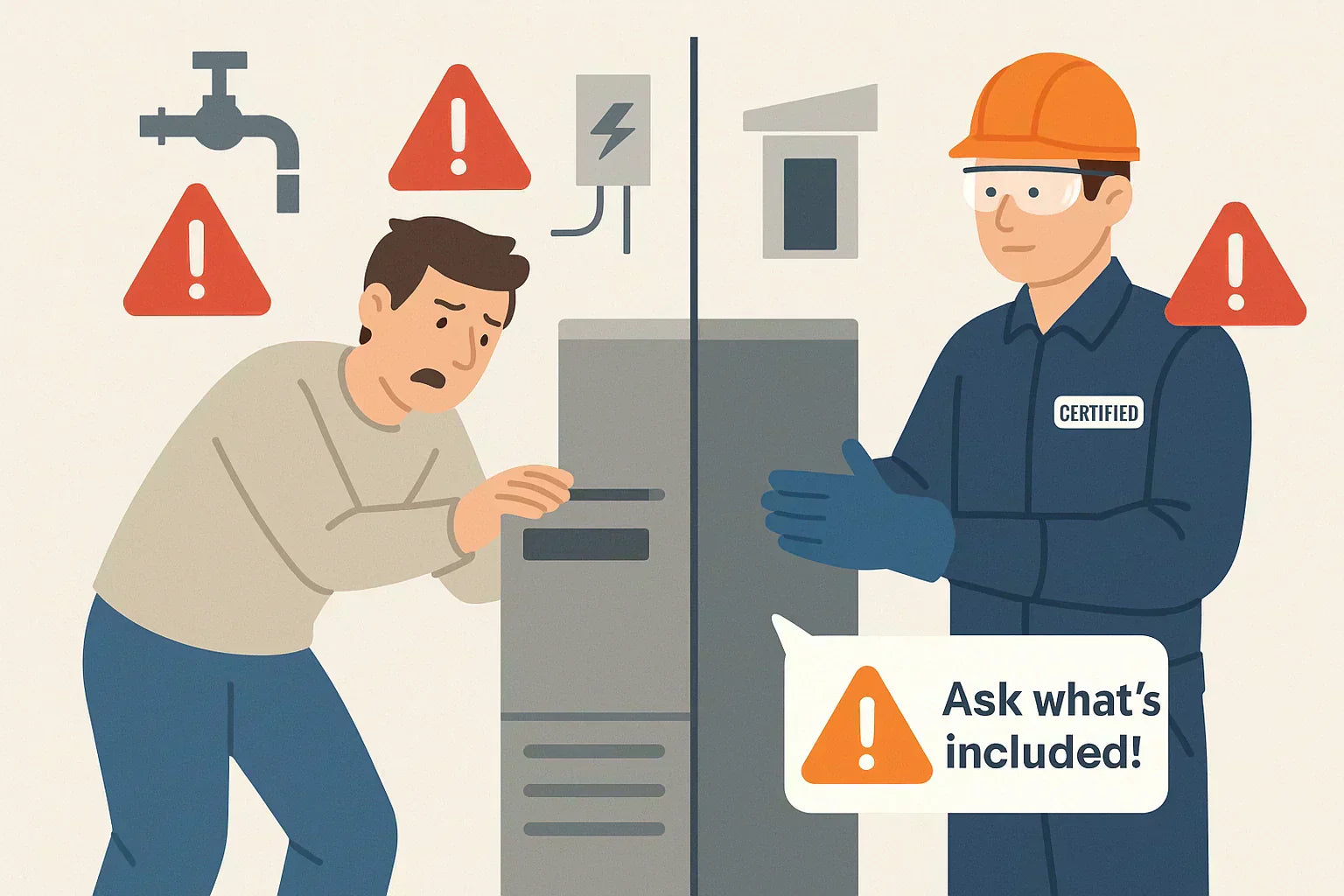By Alex Lane | Your Home Comfort Advocate
If you’ve recently shopped around for furnace installation, you may have had the same reaction I hear from many homeowners: “Wait, that’s how much for labor?”
It’s no secret that HVAC installation costs have gone up. With equipment prices rising and contractors booked weeks in advance, it’s tempting to consider installing your furnace yourself—especially if you’ve tackled DIY jobs around the house before.
But here’s the reality: installing a furnace is not like replacing a garbage disposal or wiring a thermostat. It involves complex systems, local codes, safety risks, and potential legal and warranty issues.
In this guide, we’ll break down the real cost differences between DIY and professional furnace installation, where the biggest risks lie, and how to make the safest and most cost-effective choice for your home.
🧰 Why Some Homeowners Consider DIY Furnace Installation
Let’s start with why DIY furnace installs are even on the table:
-
High labor costs: Professional installation often adds $1,500–$2,500 to your total furnace bill.
-
Online tutorials: With YouTube and forums, homeowners feel more empowered than ever.
-
Basic swaps: Some assume replacing an old unit with a similar one is “just plug and play.”
And sure, if you’re mechanically inclined and have done electrical or plumbing work, it might seem doable.
But as BuildOps points out, HVAC installs are complex—even for trained pros. You’re not just swapping metal boxes. You’re working with combustion, gas lines, live voltage, flue venting, and precise airflow.
💸 Cost Breakdown: DIY vs. Hiring a Pro
Let’s look at side-by-side numbers so you can see the full picture.
| Category | DIY Install | Pro Install |
|---|---|---|
| Furnace Equipment | $2,000–$4,000 | Included in package |
| Specialized Tools (Vac pump, torque wrench, etc.) | $500–$1,000 | Included |
| Permits & Inspections | $100–$500 | Often included |
| Labor (Your time) | Free (but risky) | $1,500–$2,500 |
| Warranty Support | None (often voided) | Full warranty coverage |
| Rework or Mistakes | Can be costly | Covered by contractor |
While DIY may look cheaper up front, the true cost can escalate quickly if you miss a step, need a redo, or fail inspection.
According to Angi, homeowners who try DIY installs often call in a professional later—after realizing they’re missing permits, lack tools, or can’t pass inspection.
⚠️ Safety, Code, and Warranty Concerns
1. Gas and Combustion Hazards
Gas leaks, carbon monoxide exposure, and flue issues are no joke. Even a small mistake can have dangerous consequences for your household.
2. Electrical Risks
Electric furnaces may require high-voltage wiring, grounding, or breaker panel upgrades. Improper wiring can lead to fire hazards or tripped circuits.
3. Local Code Requirements
Every city or county has mechanical codes and inspection protocols. Skip a required permit, and you could be forced to remove the system—or pay fines.
4. Warranty Limitations
Most manufacturers—like Lennox, Carrier, or Trane—void the warranty if the unit isn't installed by a licensed HVAC technician.
5. System Performance Issues
A poorly installed furnace can short-cycle, overheat, or underperform—driving up utility bills and reducing comfort.
Want to understand the importance of proper commissioning? Yellow Jacket explains how skipping steps like vacuuming refrigerant lines or pressurizing the system can kill performance and efficiency.
🧠 When DIY Might Make Sense (and When It Doesn’t)
There are a few limited situations where a DIY install could make sense:
✅ DIY Might Be Feasible If:
-
You’re replacing a similar electric furnace with the same voltage and airflow
-
You already have the necessary permits and tools
-
You’re a trained HVAC tech doing work on your own home (check state rules)
❌ Never DIY If:
-
It’s a gas furnace or heat pump with refrigerant lines
-
You’re modifying or extending ductwork
-
Your home’s electrical panel hasn’t been upgraded in decades
-
You’re trying to meet rebate or code requirements
Even with electric furnaces, it’s easy to overlook panel capacity or thermostat compatibility—leading to system faults.
For a reminder on proper sizing and performance considerations, see this HVAC safety and sizing guide from Australian Energy Upgrades.
🔁 The Long-Term Perspective: Is DIY Worth It?
Here’s what I tell clients: Installing a furnace is a one-time cost. But a poor install? That can cost you for years through:
-
Higher utility bills
-
Shorter equipment lifespan
-
Voided warranties
-
Failed inspections and fines
-
Safety risks that impact your insurance or family’s health
Hiring a professional may cost more upfront—but it also protects your investment and helps you qualify for rebates.
Want to understand how your choice of furnace type impacts both installation and long-term energy costs?
👉 Revisit: Gas vs. Electric Furnace Costs: What’s the Real Difference?
🛠️ DIY is Still Great For...
Don’t get me wrong—I love a good DIY project. And there’s plenty homeowners should do themselves to maintain furnace performance:
-
Replace air filters regularly
-
Install a programmable thermostat
-
Clean intake vents and outdoor units
-
Insulate ducts and seal air leaks
But when it comes to furnace installation, this is where smart DIYers know to call in the pros.
Curious about all the factors that go into your furnace replacement cost—including labor?
👉 Start with our full guide: How Much Does a New Furnace Cost?
💬 Final Thoughts from Alex Lane
You can learn a lot online. But some jobs—like installing a furnace—come with risks that aren’t worth Googling your way through.
If you’re replacing a major piece of equipment that involves gas, electricity, ductwork, and permits... it’s worth investing in professional help. Not just for safety, but for comfort, efficiency, and long-term peace of mind.
DIY has its place. Just make sure it’s not in your gas line or electrical panel.
Alex Lane
Your Home Comfort Advocate







